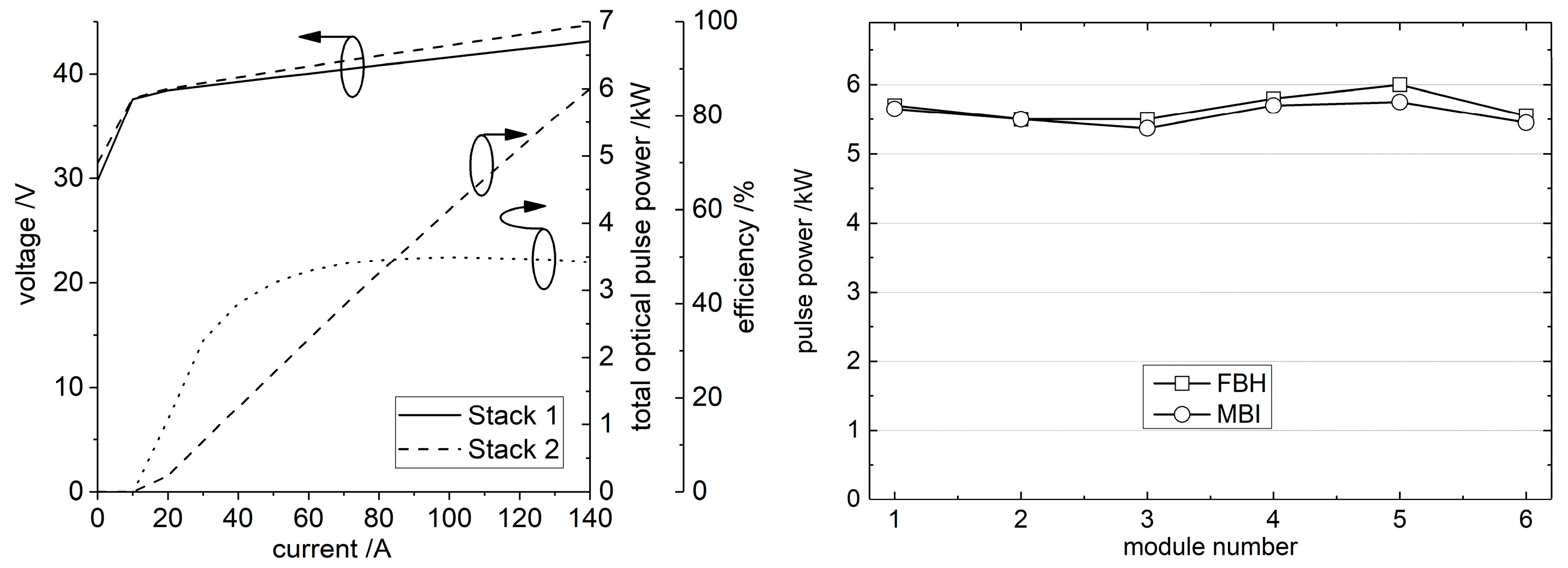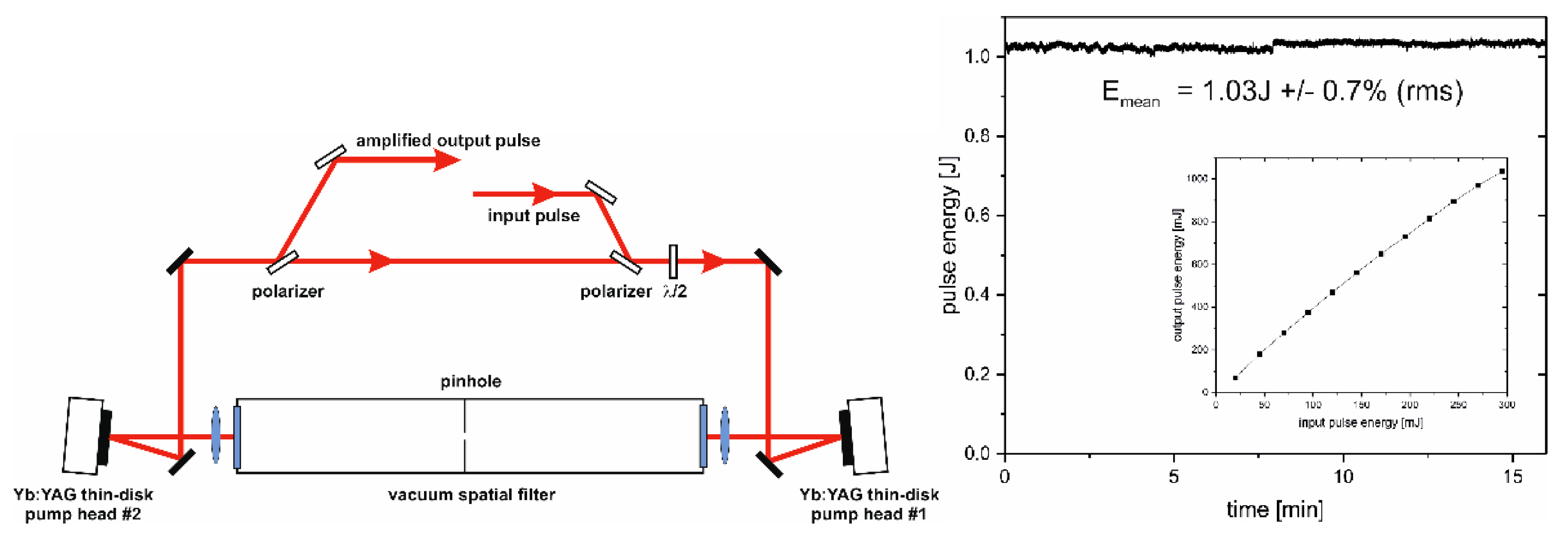Novel High-Power, High Repetition Rate Laser Diode Pump Modules Suitable for High-Energy Class Laser Facilities
Abstract
1. Introduction
2. Materials and Methods
2.1. Module Design
2.2. Optical and Electrical Power
2.3. Spectral Characteristics
2.4. Beam Quality Properties
2.5. Dynamic Thermal Impedance, Zth
3. Use of High Duty Cycle Pumps for System Development and Pumping Trials
3.1. Example 1: Diode Pumped 100…200 Hz Yb:YAG Disk Lasers (Max Born Institute, MBI)
3.2. Example 2: Initial Studies into High-Repetition Rate Pumping of Cryogenically Cooled Yb:YAG Disk Amplifiers (Institute for Optics and Quantum Electronics, IOQ Jena)
4. Conclusions
Author Contributions
Funding
Acknowledgments
Conflicts of Interest
References
- Assmann, R.; Specka, A. EuPRAXIA — A European Plasma Research Accelerator with Excellence in Applications. Available online: https://indico.cern.ch/event/489461/contributions/2168493/attachments/1305881/1951582/2016-07-01_EuPRAXIA-WP1-assmann-out.pdf (accessed on 3 July 2019).
- Mason, P.D.; Banerjee, S.; Ertel, K.; Phillips, P.J.; Butcher, T.J.; Smith, J.M.; De Vido, M.; Tomlinson, S.; Chekhlov, O.; Shaikh, W.; et al. DiPOLE100: A 100J, 10Hz DPSSL using cryogenic gas cooled Yb:YAG multi slab amplifier technology. Proc. of SPIE 2015, 9513, 951302. [Google Scholar] [CrossRef]
- De Vido, M.; Ertel, K.; Mason, P.D.; Banerjee, S.; Phillips, P.J.; Smith, J.M.; Butcher, T.J.; Chekhlov, O.; Divoky, M.; Pilar, J.; et al. A 100J-level nanosecond pulsed DPSSL for pumping high-efficiency, high-repetition rate PW-class lasers. Proc. of SPIE 2017, 10082, 100820M. [Google Scholar] [CrossRef]
- Butcher, T.; Mason, P.; Banerjee, S.; Ertel, K.; Phillips, P.J.; Smith, J.; De Vido, M.; Chekhlov, O.; Divoky, M.; Pilat, J.; et al. A 100 J-level nanosecond DPSSL for high energy density experiments. Proc. of SPIE 2017, 10238, 1023802. [Google Scholar] [CrossRef]
- Wessling, C.; Rübenach, O.; Hambücker, S.; Sinhoff, V.; Banerjeea, S.; Ertel, K.; Mason, P. Efficient pumping of inertial fusion energy lasers. Proc. of SPIE 2013, 8602, 86020I. [Google Scholar] [CrossRef]
- Bonati, G. Prospects for the Diode Laser Market. Laser Tech. J. 2010, 7, 37–40. [Google Scholar] [CrossRef]
- Fassbender, W.; Kissel, H.; Koenning, T.; Patterson, S.; Biesenbach, J. Reliable QCW diode laser arrays for operation with high duty cycles. Proc. of SPIE 2017, 10085, 1008509. [Google Scholar] [CrossRef]
- Wölz, M.; Pietrzak, A.; Kindsvater, A.; Meusel, J.; Stolberg, K.; Hülsewede, R.; Sebastian, J.; Loyo-Maldonado, V. Laser diode stacks: Pulsed light power for nuclear fusion. High Power Laser Sci. Eng. 2016, 4, e14. [Google Scholar] [CrossRef][Green Version]
- Zhang, P.; Liu, X.; Zhu, Q.; Wang, J. Thermal characteristics of compact conduction-cooled high power diode laser array packages. Proc. of SPIE 2017, 10085, 100850A. [Google Scholar] [CrossRef]
- Kindsvater, A.; Schröder, M.; Werner, E.; Seidel, S.; Wölz, M.; Loyo-Maldonado, V. High duty-cycle, high-efficiency QCW stacks for medical applications. Proc. of SPIE 2016, 9733, 97330M. [Google Scholar] [CrossRef]
- Platz, R.; Eppich, B.; Rieprich, J.; Pittroff, W.; Erbert, G.; Crump, P. High duty cycle, highly efficient fiber coupled 940-nm pump module for high-energy solid-state lasers. High Power Laser Sci. Eng. 2016, 4, e3. [Google Scholar] [CrossRef][Green Version]
- Platz, R.; Frevert, C.; Eppich, B.; Rieprich, J.; Ginolas, A.; Kreutzmann, S.; Knigge, S.; Erbert, G.; Crump, P. Progress in high duty cycle, highly efficient fiber coupled 940-nm pump modules for high-energy class solid-state lasers. Proc. of SPIE 2018, 10513, 1051319. [Google Scholar] [CrossRef]
- Crump, P.; Karow, M.M.; Knigge, S.; Maasdorf, A.; Traenkle, G.; Lotz, J.; Fassbender, W.; Neukum, J.; Körner, J.; Boedefeld, R.; et al. Progress in joule-class diode laser bars and high brightness modules for application in long-pulse pumping of solid state amplifiers. Proc. of SPIE 2017, 10086, 100860E. [Google Scholar] [CrossRef]
- Pittroff, W.; Eppich, B.; Erbert, G.; Platz, R.; Tyralla, D.; Tränkle, G. Simple design for fiber coupled 9xx nm kW-QCW pump module with high duty cycle based on customized chips and lateral heat removal. Proc. of SPIE 2014, 8965, 896515. [Google Scholar] [CrossRef]
- Negoita, V.C.; Vethake, T.; Jiang, J.; Roff, R.; Shih, M.; Duck, R.; Bauer, M.; Mite, R.; Boucke, K.M.; Treusch, G. High peak power diode stacks for high energy lasers. Proc. of SPIE 2015, 9345, 934504. [Google Scholar] [CrossRef]
- Körner, J.; Jambunathan, V.; Hein, J.; Seifert, R.; Loeser, M.; Siebold, M.; Schramm, U.; Sikocinski, P.; Lucianetti, A.; Mocek, T.; et al. Spectroscopic characterization of Yb3+-doped laser materials at cryogenic temperatures. Appl. Phys. B 2014, 116, 75. [Google Scholar] [CrossRef]
- ISO 11146-2:2005. Lasers and laser-related equipment - Test methods for laser beam widths, divergence angles and beam propagation ratios - Part 2: General astigmatic beams. Available online: https://www.iso.org/standard/33626.html (accessed on 3 July 2019).
- Winterfeldt, M.; Crump, P.; Knigge, S.; Maaßdorf, A.; Zeimer, U.; Erbert, G. High Beam Quality in Broad Area Lasers via Suppression of Lateral Carrier Accumulation. IEEE Photonics Technol. Lett. 2015, 27, 1809. [Google Scholar] [CrossRef]
- Winterfeldt, M.; Crump, P.; Wenzel, H.; Erbert, G.; Tränkle, G. Experimental investigation of factors limiting slow axis beam quality in 9xx nm high power broad area diode lasers. J. Appl. Phys. 2014, 116, 063103. [Google Scholar] [CrossRef]
- Huber, M.; Saupe, F.; Wuest, P.; Forrer, H.; Kunz, A.; Moser, H. Impact of absorption in fast axis collimation lenses. Proc. of SPIE 2018, 10513, 105130P. [Google Scholar] [CrossRef]
- Liu, X.; Hu, M.H.; Caneau, C.G.; Bhat, R.; Zah, C.-E. Thermal management strategies for high power semiconductor pump lasers. IEEE Trans. Compon. Packag. Technol. 2006, 29, 268. [Google Scholar] [CrossRef]
- Székely, V. A new evaluation method of thermal transient measurement results. Microelectron. J. 1997, 28, 277. [Google Scholar] [CrossRef]
- Pittroff, W.; Erbert, G.; Beister, G.; Bugge, F.; Klein, A.; Knauer, A.; Maege, J.; Ressel, P.; Sebastian, J.; Staske, R.; et al. Mounting of high power laser diodes on boron nitride heat sinks using an optimized Au/Sn metallurgy. IEEE Trans. Adv. Packag. 2001, 24, 434. [Google Scholar] [CrossRef]
- Tümmler, J.; Jung, R.; Stiel, H.; Nickles, P.V.; Sandner, W. High-repetition-rate chirped-pulse-amplification thin-disk laser system with joule-level pulse energy. Opt. Lett. 2009, 34, 1378. [Google Scholar] [CrossRef]
- Stiel, H.; Tümmler, J.; Jung, R.; Nickles, P.V.; Sandner, W. X-ray laser takes the 100 Hz barrier. Proc. of SPIE 2009, 7451, 745109. [Google Scholar] [CrossRef]
- Jung, R.; Tümmler, J.; Will, I. Regenerative thin-disk amplifier for 300 mJ pulse energy. Opt. Express 2016, 24, 883. [Google Scholar] [CrossRef] [PubMed]
- Will, I.; Tümmler, J.; Nubbemeyer, T.; Jung, R.; Sandner, W. Vorrichtung zur Verstärkung von Gepulster Laserstrahlung mit Hoher Energie der Laserpulse und Hoher Mittlerer Leistung. German Patent No. DE102013208377, 7 May 2013. [Google Scholar]
- Jung, R.; Tümmler, J.; Nubbemeyer, T.; Will, I. Two-Channel Thin-Disk Laser for High Pulse Energy. Proc. of SPIE 2015, AW3A.7. [Google Scholar] [CrossRef]
- Körner, J.; Yue, F.; Hein, J.; Kaluza, M.C. Spatially and temporally resolved temperature measurement in laser media. Opt. Lett. 2016, 41, 2525. [Google Scholar] [CrossRef]








| Source | Aperture [cm2] | Solid Angle [sr] | Peak Optical Power Popt [kW] | Brightness B [MW/cm2/sr] | Repetition Rate, f [Hz] | Pulse Width, τp [ms] | Wavelength [nm] |
|---|---|---|---|---|---|---|---|
| Anticipated pump requirement for EuPRAXIA “Laser 3” | |||||||
| 300–1200 | 0.8-1.0 | 20..100 | 0.5…2 | 940 | |||
| Results here | |||||||
| FBH *, Stack | 1.1 | 0.00131 | 3.6 | 2.57 | 1000…1 | 0.1…100…(cw) | 940 |
| FBH, Module | 1.1 | 0.00131 | 6 | 4.29 | 1000…1 | 0.1…100…(cw) | 940 |
| Other publications | |||||||
| [5], Stack | 1.3 | 0.00120 | 2.2 | 1.41 | 10 | 1 | 808/940 |
| [5], Module | 4.0 | 0.01065 | 20 | 0.47 | 10 | 1 | 940 |
| [10], 8 bars | 1.2 | 0.00120 | 0.5 | 0.36 | 1.375/3 | 400/50 | 810 |
| [10], 12 bars | 1.3 | 0.00120 | 1.08 | 0.68 | 2 | 100 | 810 |
| [7] con | 1.2 | 0.00120 | 4.4 | 3.07 | 10 | 1.2 | 980 (“766–1550”) |
| [7] in | 1.9 | 0.00120 | 1.32 | 0.59 | 1.375/3/400 | 400/50/0.2 | 980 (“766–1550”) |
| [7], Module mcc | 111.6 | 0.00120 | 250 | 1.86 | 400 | 0.2 | 808 |
| [9], 3 bars | 0.2 | 0.00120 | 0.7 | 2.91 | 50 | 0.25 | 808 |
| [9], 5 bars | 0.4 | 0.00120 | 1.5 | 3.11 | 20 | 0.25 | 808 |
| [13], 8 bars | 1.3 | 0.00106 | 4.8 | 3.58 | 10 | 1 | 935 |
| [2], DiPOLE100 | 62.4 | 0.00381 | 250 | 1.05 | 10 | 1 | 940 |
| [15], 25 bars | 4.3 | 0.00094 | 12 | 3.07 | 10 | 1 | 938 (“880–1000”) |
| Mode of Operation, Duty Cycle = 10% | M2, Horizontally | M2, Vertically |
|---|---|---|
| Pulsed, τ = 100 µs, 1 kHz | 283 | 409 |
| Pulsed, τ = 1000 µs, 100 Hz | 313 | 436 |
| Pulsed, τ = 100 ms, 1 Hz | 428 | 491 |
| cw | 384 | 454 |
© 2019 by the authors. Licensee MDPI, Basel, Switzerland. This article is an open access article distributed under the terms and conditions of the Creative Commons Attribution (CC BY) license (http://creativecommons.org/licenses/by/4.0/).
Share and Cite
Hübner, M.; Will, I.; Körner, J.; Reiter, J.; Lenski, M.; Tümmler, J.; Hein, J.; Eppich, B.; Ginolas, A.; Crump, P. Novel High-Power, High Repetition Rate Laser Diode Pump Modules Suitable for High-Energy Class Laser Facilities. Instruments 2019, 3, 34. https://doi.org/10.3390/instruments3030034
Hübner M, Will I, Körner J, Reiter J, Lenski M, Tümmler J, Hein J, Eppich B, Ginolas A, Crump P. Novel High-Power, High Repetition Rate Laser Diode Pump Modules Suitable for High-Energy Class Laser Facilities. Instruments. 2019; 3(3):34. https://doi.org/10.3390/instruments3030034
Chicago/Turabian StyleHübner, Marko, Ingo Will, Jörg Körner, Jürgen Reiter, Mathias Lenski, Johannes Tümmler, Joachim Hein, Bernd Eppich, Arnim Ginolas, and Paul Crump. 2019. "Novel High-Power, High Repetition Rate Laser Diode Pump Modules Suitable for High-Energy Class Laser Facilities" Instruments 3, no. 3: 34. https://doi.org/10.3390/instruments3030034
APA StyleHübner, M., Will, I., Körner, J., Reiter, J., Lenski, M., Tümmler, J., Hein, J., Eppich, B., Ginolas, A., & Crump, P. (2019). Novel High-Power, High Repetition Rate Laser Diode Pump Modules Suitable for High-Energy Class Laser Facilities. Instruments, 3(3), 34. https://doi.org/10.3390/instruments3030034






